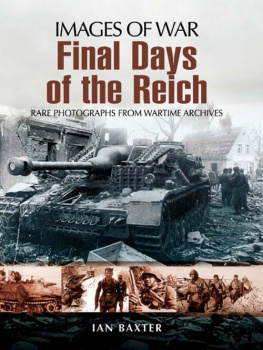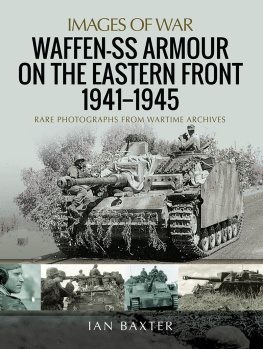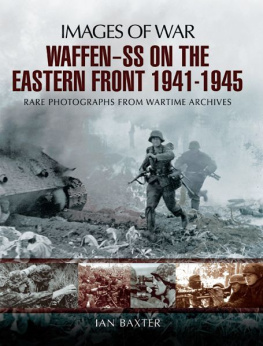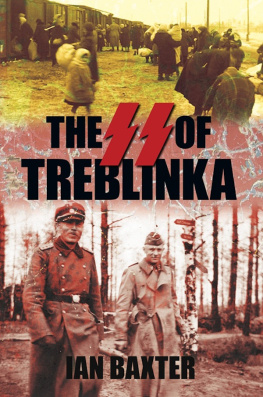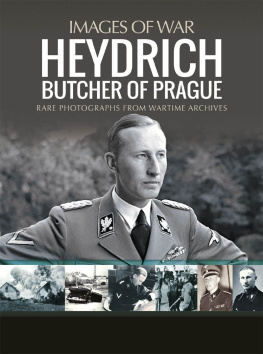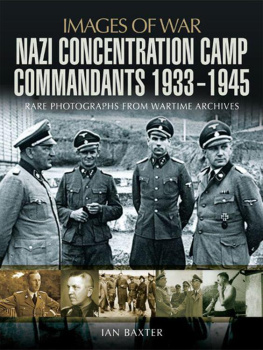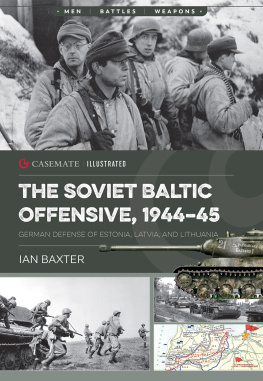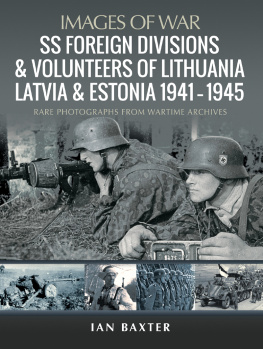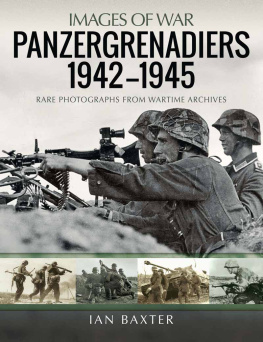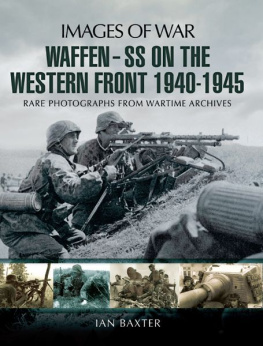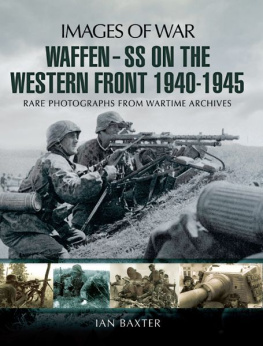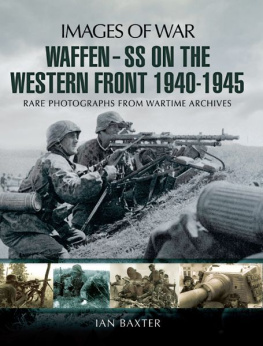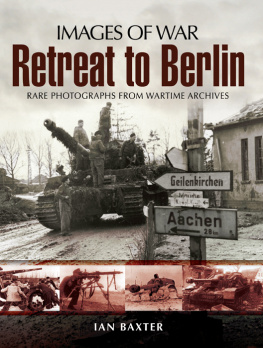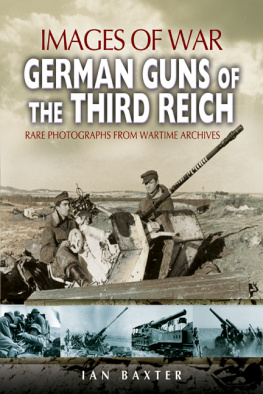
First published in Great Britain in 2011 by
PEN & SWORD MILITARY
an imprint of
Pen & Sword Books Ltd,
47 Church Street, Barnsley,
South Yorkshire.
S70 2AS
Copyright Ian Baxter 2011
ISBN 978-1-84884-381-3
The right of Ian Baxter to be identified as Author of
this Work has been asserted by him in accordance with the
Copyright, Designs and Patents Act 1988.
A CIP catalogue record for this book is available
from the British Library
All rights reserved. No part of this book may be reproduced or transmittedin any form or by any means, electronic or mechanical including photocopying,recording or by any information storage and retrieval system,without permission from the Publisher in writing.
Typeset by Mac Style, Beverley, East Yorkshire
Printed and bound in Great Britain by CPI
Pen & Sword Books Ltd incorporates the imprints ofPen & Sword Books Ltd incorporates the Imprints of Pen & Sword Aviation, Pen & Sword Family History, Pen & Sword Maritime, Pen & Sword Military, Pen & Sword
Discovery, Wharncliffe Local History, Wharncliffe True Crime, Wharncliffe Transport, Pen & Sword Select, Pen & Sword Military Classics, Leo Cooper, The Praetorian Press,Remember When, Seaforth Publishing and Frontline Publishing
For a complete list of Pen & Sword titles please contact:
PEN & SWORD BOOKS LIMITED
47 Church Street, Barnsley, South Yorkshire, S70 2AS, England.
E-mail:
Website: www.pen-and-sword.co.uk
Introduction
Drawing on a superb collection of rare German photographs this new Images of War series covers the last battles fought by the Wehrmacht and their SS counterparts following their crushing defeat on the Eastern Front. These German forces that survived the constant enemy artillery barrages, the onslaught of the tank armadas and mass infantry assaults, had streamed back westwards, towards the river oder, the last bastion of defence before Berlin, where they continued fighting vicious defensive battles until there units either run out of ammunition or were killed.
Throughout the book it provides an absorbing insight into the bitter final days of the Reich. It reveals how the remnants of Hitlers once vaunted force were hurled back into a devastated Reich and ordered to wage an unprecedented war of attrition against an overwhelming foe. Along the River oder where the German soldier stood on the fringes of the Reich capital they were ordered to fight a series of colossal blood-thirsty battles in a desperate attempt to hold the disintegrating front. It reveals in detail, accompanied by extensive in-depth captions, how the Germans were slowly driven from their decimated positions and forced to fight, being pushed further west until they stood fighting in the rubble strewn streets of Berlin. But Hitler still obsessed with the belief that fanatical aggression could hold-back the enemy tried to pour the last of his resources into the battle in a fanatical attempt to win time.
The Final Days of the Reich is a unique study of a struggling German Army trying in vain to avoid being sucked into a maelstrom of destruction. From the last battles fought on Russian and Baltic soil, to the final show-down in front of Berlin, the book reveals an horrendous story of an armies desperate attempt to survive in one of the most important visual records of Germanys demise of the Reich.
Photographic Acknowledgements
It is with the greatest pleasure that I use this opportunity on concluding this book to thank those who helped make this volume possible. My expressions of gratitude first goes to my photographic collector Michael Cremin. He has been an unfailing source; supplying me with a number of photographs that were obtained from numerous private sources.
In Poland I am also extremely grateful to Marcin kaludow, my Polish photographic specialist, who supplied me with a variety of photographs that he sought from private photographic collections in Poland.
Chapter 1
Defending the East
During the last months of 1944 the situation for the German soldier on the Eastern Front was dire. They had fought desperately to maintain cohesion and hold their meagre positions that often saw thousands perish. By September 1944 they were still holding a battle line more than 1,400 miles in overall length, which had been severely weakened by the overwhelming strength of the Red Army. To make matters worse troop units were no longer being refitted with replacements to compensate for the large losses sustained. Supplies of equipment and ammunition too were so insufficient in some areas of the front that commanders were compelled to ration ammunition to their men. As a consequence many soldiers had become increasingly aware that they were in the final stages of the war in the East, and this included battle-hardened combatants. They had also realized that they were now fighting an enemy that was far superior to them. As a consequence in a number of sectors of the front soldiers were able to realistically assess the war situation and this in turn managed to save the lives of many that would normally have been killed fighting to the last man.
In spite of the adverse situation in which the German soldier was placed he was still strong and determined to fight with courage and skill. During the last six months of the war the German soldier had expended considerable combat efforts lacking sufficient reconnaissance and the necessary support of tanks and heavy weapons to ensure any type of success. Ultimately, the German soldier during the last months of the war was ill prepared against any type of large-scale offensive. The infantry defensive positions relied upon sufficient infantry ammunition supply and the necessary support to ensure that they would able to hold their fortified areas. Without this, the German soldier was doomed. Commanders in the field were fully aware of the significant problems and the difficulties imposed by committing badly equipped soldiers to defend the depleted lines of defence. However, in the end, they had no other choice than to order their troops to fight with whatever they had at their disposal.
In the last months of the war German forces continued retreating across a scarred and devastated wasteland. on both the Western and Eastern Fronts, the last agonising moments of the war were played out. Whilst the British and American troops were poised to cross the River Rhine, in the East the terrifying advance of the Red Army was bearing down on the River oder, pushing back the last remnants of Hitlers exhausted units.
Due to a serious lack of troop reserves many parts of the front were now defended by a mixed number of local militia, postal defence units, locally raised anti-tank groups, Wehrmacht, Waffen-SS and Allegemeine-SS formations, Hitlerjugend, and units of the Volkssturm. But surprisingly, even in the rank and file of the Volkssturm, morale remained high. For these ordinary men of Germanys Home Guard units they needed no propaganda to urge them on. They knew, like all those defending the Fatherland that they were fighting now to defend their homes and loved ones. All that what was left to them was their skill and courage. Everything else, guns, planes, and armoured vehicles had already been sacrificed. Spread among these under-armed forces was a mixed bag of strong and weak Wehrmacht and Waffen-SS troops. In some areas of the front there were good defensive lines comprising mazes of intricate blockhouses and trenches. Towns that fell in the path of these defensive belts were evacuated. Thousands of women, children and old men were removed from their dwellings and some were actually pressed into service to help construct massive anti-tank ditches and other obstacles.
Next page
